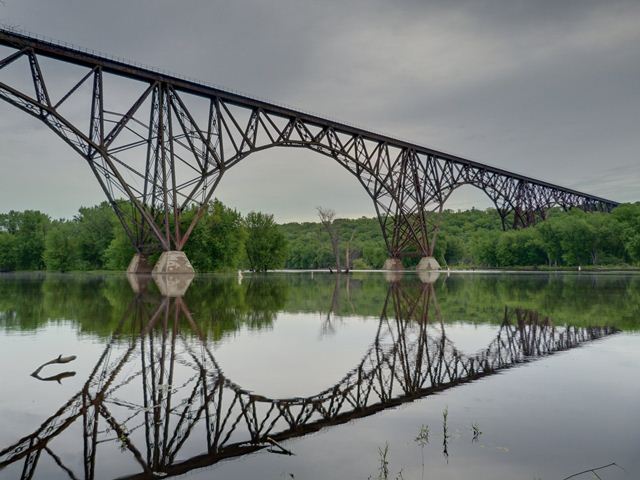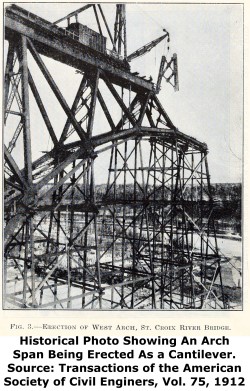We Recommend:
Bach Steel - Experts at historic truss bridge restoration.
BridgeHunter.com Phase 1 is released to the public! - Visit Now
Soo Line High Bridge
Arcola High Bridge

Primary Photographer(s): Nathan Holth
Bridge Documented: June 2, 2013
Rural: Washington County, Minnesota and St. Croix County, Wisconsin: United States
Metal 7 Panel Three-Hinged Solid Ribbed Spandrel Braced Deck Arch, Fixed and Approach Spans: Metal Deck Girder, Fixed
1911 By Builder/Contractor: American Bridge Company of New York, New York and Engineer/Design: Claude Allen Porter Turner of Minneapolis, Minnesota
Not Available or Not Applicable
350.0 Feet (106.7 Meters)
2,682.0 Feet (817.5 Meters)
Not Available
5 Main Span(s) and 8 Approach Span(s)
Not Applicable

View Information About HSR Ratings
Bridge Documentation
View A Detailed Historical Discussion of this Bridge By Designer C. A. P. Turner
View A Historical Article Discussing This Bridge
This bridge is one of the most impressive and historically significant steel arch bridges in the country. It was designed by Claude Allen Porter Turner (C.A.P. Turner) who was the inventor of the Turner truss configuration and also a leader in the design of concrete structures. The main arch spans are unusual, beautiful, and technologically noteworthy. This bridge with its five steel arch spans is a rare example of a multi-span steel spandrel braced deck arch bridge, which gives the bridge a distinctive appearance. They are three hinged steel arches, and the arches are inclined, meaning at the top (crown) of the arch, the distance between the arch ribs is lesser than it is at the base (at the piers). At the top, where the distance is more narrow, an innovative deck design was used, taking advantage of the top chords of the arch and using them to directly support the railroad tracks, which avoided the use of floor beams and deck stringers that are so common on metal arch and truss bridges. Three hinged arch bridges were traditionally considered undesirable for railroad use due to their lesser rigidity. However, this bridge was designed with substantial depth remaining in the structure even at the crown to help eliminate this lack of rigidity. Additionally, the bridge was designed with a special friction plate system in the crown hinge. When a live load (train) crosses the bridge, these plates lock together by friction, preventing motion in the hinge while the train is on the bridge and for that time making the bridge act like a two hinged arch bridge. Finally, it is interesting to note that this arch bridge does not have any vertical columns in the arch design, and instead relies on a series of diagonals, much like a Warren truss configuration. The use of a Warren-like pattern of repeating triangles in the arch is perhaps not surprising when you consider that C.A.P. Turner invented the Turner truss configuration, which is a variation on the Warren truss that also excluded verticals. C.A.P. Turner does not seem to have liked verticals!
The railroad line passes over the river at nearly 185 feet above the normal water level.
This bridge was built for the Wisconsin Central Railroad, which was a system leased by the Minneapolis, St. Paul and Sault Ste. Marie Railway, which is also known as the Soo Line. The high level bridge which passes over the St. Croix River and associated river valley was constructed to provide a shorter, more economical route for the railroad line. The previous bridge located 3/4 mile south of the existing bridge crossed at a lower level and forced trains to have to deal with a steep grade up and down the river valley.
There is a reason such an unusual bridge type was used here. Building a more traditional high level plate girder bridge with 100 foot spans between 40 foot long tower bents was considered. However, the short spans of a plate girder bridge would have required many piers. Due to the conditions at this location, the piers would have been more expensive than usual, making this a more expensive alternative. Also more expensive was an alternative proposed by the McClintic-Marshall Construction Comapany to use 200 foot lattice truss spans. Regarding the alternative to use long arch spans, both concrete and steel designs were considered. An additional advantage above the cost of a girder structure was that the larger piers needed for the arch spans would be more stable and resistant to scour. Additionally, the arch spans provided top chords for the deck to rest on, which were stronger than what the girder spans would have provided.
This bridge's substructure is concrete which is built upon wooden piles of Norway pine. A temporary chute and trestle structure had to be constructed to carry the concrete from the mixing site on one of the bluffs down to the piers.
The American Bridge Company fabricated the bridge parts. The Kelly-Atkinson Construction Company, a noted Chicago bridge contractor was the on-site builder who erected the bridge. Some portions of the arches were erected with extensive falsework, while other arches were able to be erected using the cantilever method, which eliminated the need for falsework in those areas.
This bridge remains active for trains and is owned by Canadian National. Like most railroad companies, Canadian National is a private company whose primary goal is profit. Since historic bridge preservation in itself does not directly translate to railroad company profit, it is not surprising that historic preservation of railroad bridges is rare. Railroad bridges that survive only survive because it is usually more economical to maintain existing bridges rather than waste money on costly demolition and replacement projects. However, many railroad bridges across the county are being demolished and replaced, often because railroad companies want to run heavier trains on the bridges than the bridges were designed for. Given the extremely high significance of this railroad bridge, it is therefore hoped that this bridge remains strong enough to handle the trains that Canadian National wants to run on the bridge. Even among railroad companies, Canadian National stands out for demolishing a lot of very rare historic bridges, particularly in the Midwest United States.
Please be sure to view the photo gallery for this bridge which includes some impressive aerial photos shared by Jim Myerly.
![]()
Photo Galleries and Videos: Soo Line High Bridge
Bridge Photo-Documentation
Original / Full Size PhotosA collection of overview and detail photos. This gallery offers photos in the highest available resolution and file size in a touch-friendly popup viewer.
Alternatively, Browse Without Using Viewer
![]()
Bridge Photo-Documentation
Mobile Optimized PhotosA collection of overview and detail photos. This gallery features data-friendly, fast-loading photos in a touch-friendly popup viewer.
Alternatively, Browse Without Using Viewer
![]()
Maps and Links: Soo Line High Bridge
This bridge is best viewed and approached from the west, where you can walk trails through a
Coordinates (Latitude, Longitude):
Search For Additional Bridge Listings:
Bridgehunter.com: View listed bridges within 0.5 miles (0.8 kilometers) of this bridge.
Bridgehunter.com: View listed bridges within 10 miles (16 kilometers) of this bridge.
Additional Maps:
Google Streetview (If Available)
GeoHack (Additional Links and Coordinates)
Apple Maps (Via DuckDuckGo Search)
Apple Maps (Apple devices only)
Android: Open Location In Your Map or GPS App
Flickr Gallery (Find Nearby Photos)
Wikimedia Commons (Find Nearby Photos)
Directions Via Sygic For Android
Directions Via Sygic For iOS and Android Dolphin Browser
USGS National Map (United States Only)
Historical USGS Topo Maps (United States Only)
Historic Aerials (United States Only)
CalTopo Maps (United States Only)






